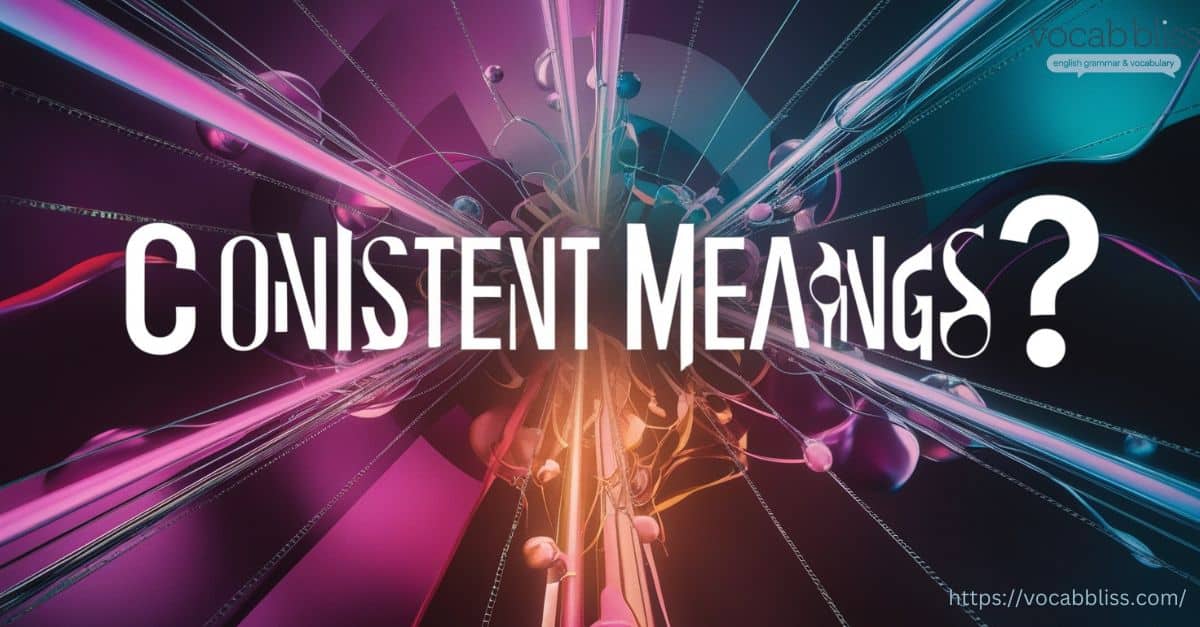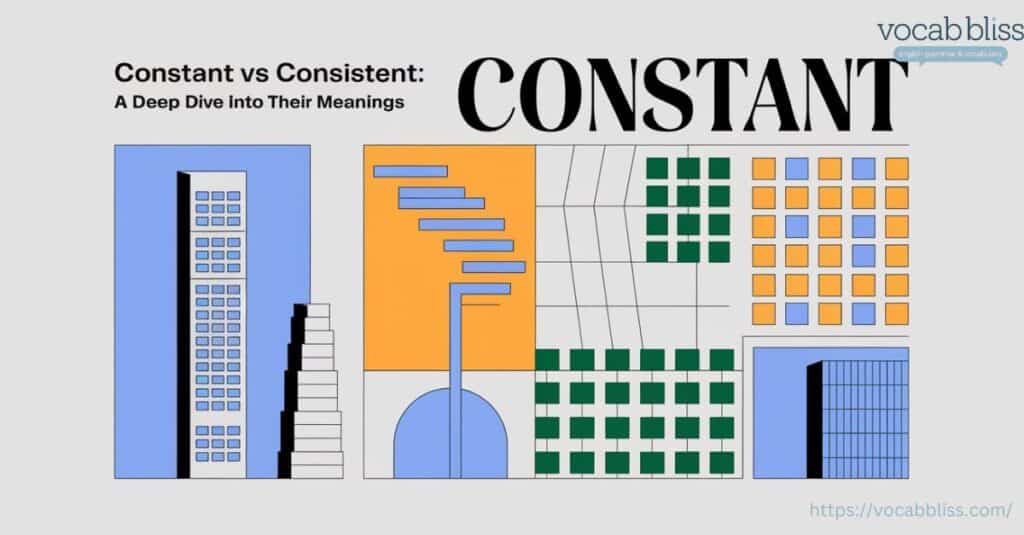When it comes to the English language, subtle differences between words like “Constant vs Consistent“ can leave many scratching their heads. Although these terms are closely related, their nuanced meanings and applications set them apart in significant ways. In this article, we’ll break down the difference between Constant and Consistent, explore their definitions, usage in everyday language, and provide examples to ensure you never confuse them again.
Quick Summary
Understanding the distinction between Constant vs Consistent is essential for clear and effective communication. While both terms imply reliability, they emphasize different qualities: constant refers to something unchanging and uninterrupted, like the steady hum of a machine or unwavering love. On the other hand, consistent focuses on regularity and dependability over time, such as maintaining steady performance or adhering to a set standard. These subtle differences often cause confusion, but by examining their definitions, usage, and real-world examples, you can master their application in both writing and speech.
Continue reading: Pick Up or Pickup, Pick-Up: How Should It Be Used?
Core Differences Between “Constant vs Consistent”
At first glance, Consistent vs Constant terms might seem interchangeable, but their specific meanings and usage differ significantly:
| Aspect | Consistent | Constant |
|---|---|---|
| Definition | Regular and in agreement with past actions. | Continuous, unchanging, or without interruption. |
| Context | Behavior, performance, or patterns. | Time, presence, or unending occurrence. |
| Key Attribute | Dependability and reliability. | Permanence and unchangeability. |
| Examples | “Her work ethic is consistent.” | “The ticking of the clock is constant.” |
By examining their characteristics side-by-side, it becomes clear why consistent often relates to dependability while constant pertains to unchanging states.
Detailed Understanding of “Constant vs Consistent”
Consistent Meanings?

The term consistent captures the idea of stability, dependability, and adherence to a specific pattern or standard over time. Specifically, it describes behaviors, processes, or results that remain aligned and predictable, thereby reflecting reliability and commitment. Furthermore, through this regularity, consistency ensures a sense of trust and dependability, ultimately creating a steady foundation.
Definition with Context and Nuances
- In General Terms:
- Consistent implies steadiness or regularity in action, thought, or appearance.
- For example: “Her diet is consistent, ensuring balanced meals every day.”
- In Personal Habits:
- Reflects dependability in routines or actions.
- For instance: “Practicing piano consistently leads to noticeable improvement.”
- In Performance:
- Refers to maintaining a certain level of quality or achievement without significant fluctuation.
- Example: “The athlete’s consistent performance secured her a place on the national team.”
- In Opinions and Beliefs:
- Signifies alignment with previously expressed thoughts or principles.
- Example: “His consistent stance on environmental policies earned public trust.”
Examples of Usage
- “The branding was consistent across all marketing materials, creating a cohesive image.”
- “Her consistent study habits were the key to her academic success.”
- “A consistent temperature is crucial for laboratory experiments.”
Synonyms and Related Terms
- Steady
- Reliable
- Uniform
- Predictable
- Dependable
These terms reinforce the essence of consistent as something that remains steady over time, fostering trust and reliability.
Constant Meanings?
The word constant embodies the idea of permanence, continuity, and unchanging presence. Moreover, it is often associated with events, states, or processes that persist without interruption or variation, thereby providing a sense of unwavering stability.
Definition with Context and Nuances
- In General Terms:
- Constant refers to something that endures or persists indefinitely without fluctuation.
- Example: “Her constant support gave me the strength to keep going.”
- In Scientific Contexts:
- Often used to describe values or phenomena that remain unchanged under specific conditions.
- Example: “The speed of light is a constant in physics, fundamental to scientific theories.”
- In Emotional Contexts:
- Describes feelings or relationships that remain steady and enduring.
- Example: “A parent’s constant love is a cornerstone of a child’s life.”
- In Time and Space:
- Refers to elements that are always present or occurring.
- Example: “The constant ticking of the clock reminded them of the passing hours.”
Examples of Usage
- “The river’s flow is constant, carving its way through the valley.”
- “In the chaos of life, her friendship remained a constant source of comfort.”
- “The company aims to provide constant innovation to stay ahead in the market.”
Synonyms and Related Terms
- Unchanging
- Perpetual
- Continuous
- Persistent
- Unwavering
These synonyms, moreover, highlight the enduring and unalterable nature of constant, thereby emphasizing its role in conveying permanence and continuity.
By understanding the nuances and applications of Consistent vs Constant, you can confidently use these terms to communicate with clarity and precision, whether in casual conversation or professional writing.
Direct Comparison: Consistent vs Constant
When examining Consistent vs Constant, a side-by-side comparison helps clarify their meanings, usage, and contexts. Here’s a revised version of your sentence with transition words added:
Below is a comprehensive table that not only outlines their differences but also highlights areas where they might overlap or, in some cases, cause confusion.
| Aspect | Consistent | Constant |
|---|---|---|
| Definition | Reflects reliability, steadiness, or alignment over time. | Refers to something unchanging, persistent, or ongoing without interruption. |
| Usage Contexts | – Regular habits or patterns. |
- Dependable outcomes or behaviors.
- Alignment with prior actions or standards. | - Continuous timeframes or states.
- Uninterrupted presence or activity.
- Persistent emotions or physical phenomena. |
| Examples | – “Her consistent performance made her a team leader.”
The teacher’s consistent grading system reassured the students, providing a sense of fairness and predictability. Meanwhile, the constant hum of machinery filled the factory, creating a rhythmic backdrop to the workers’ daily routines.- “The northern star is a constant guide for sailors.” |
| Key Attributes | – Steady but adaptable.
– Relates to trust and dependability.
– Indicates alignment with standards or expectations. | – Unwavering and unchanging.
– Often tied to permanence or persistence.
– Indicates lack of interruption. |
Situations Where Terms Might Overlap or Confuse Users
Overlaps in Usage:
Both terms can describe reliability or presence, but their emphasis differs:
- In Relationships:
- Consistent: “He is consistent in showing up for his friends.” (Reliable behavior.)
- Constant: “Her constant encouragement keeps him motivated.” (Unwavering presence.)
- In Work Environments:
- Consistent: “The manager’s consistent communication style ensures clarity.”
- Constant: “The constant pressure to meet deadlines can feel overwhelming.”
Potential Confusion:
- Similar Connotations: Both imply dependability, but consistent focuses on regularity, while constant emphasizes continuity.
- Overlap in Descriptions: For example, describing someone as “a constant source of support” versus “a consistent supporter” can seem interchangeable. The key lies in whether the emphasis is on unwavering presence (constant) or dependable actions (consistent).
Practical Applications and Examples

Understanding how to use Constant vs Consistent effectively can elevate your communication skills and reduce misunderstandings. Here are examples and scenarios across different aspects of life, business, and education to illustrate their proper usage, alongside common pitfalls to avoid.
Examples from Daily Life
- Consistent:
- “She is consistent in watering her plants every morning, which keeps them healthy.”
(This emphasizes regularity and routine.) - “His workouts are consistent, helping him achieve his fitness goals.”
- “She is consistent in watering her plants every morning, which keeps them healthy.”
- Constant:
- “The constant noise from traffic makes it hard to concentrate.”
(Here, it describes an uninterrupted presence.) - “The constant ticking of the clock was a reminder of the approaching deadline.”
- “The constant noise from traffic makes it hard to concentrate.”
Common Misuse:
- Saying “She is constant in her study habits” instead of “She is consistent in her study habits.”
(Consistency applies to habits because it emphasizes reliability, not unchanging presence.)
Examples from Business
- Consistent:
- “The company maintains consistent quality in its products, ensuring customer satisfaction.”
(This highlights the regularity of high standards.) - “A consistent marketing strategy across all platforms strengthens brand identity.”
- “The company maintains consistent quality in its products, ensuring customer satisfaction.”
- Constant:
- “The constant demand for innovation pushes businesses to evolve rapidly.”
(Describes an ongoing and unchanging force.) - “A constant connection with customers builds long-term loyalty.”
- “The constant demand for innovation pushes businesses to evolve rapidly.”
Common Misuse:
- Writing “The business showed constant improvement” instead of “The business showed consistent improvement.”
(Improvement implies a process that unfolds steadily, making consistent the appropriate choice.)
Examples from Relationships
- Consistent:
- “He is consistent in calling his family every weekend.”
(This demonstrates dependability and a repeated action.) - “Her consistent support during tough times strengthened their friendship.”
- “He is consistent in calling his family every weekend.”
- Constant:
- “Her constant love for her children is evident in everything she does.”
(Indicates an enduring and uninterrupted feeling.) - “The constant presence of a mentor can make a significant impact on personal growth.”
- “Her constant love for her children is evident in everything she does.”
Common Misuse:
- Saying “He is constant in his efforts to learn” instead of “He is consistent in his efforts to learn.”
(Efforts are typically described as regular and ongoing, aligning with consistent.)

Examples from Education
- Consistent:
- “Consistent study habits lead to better grades and deeper understanding of the material.”
- “The teacher’s consistent approach to discipline ensures fairness in the classroom.”
- Constant:
- “The constant pursuit of knowledge drives innovation in the field of science.”
- “The constant availability of online resources makes learning more accessible.”
Common Misuse:
- Saying “The teacher maintained constant rules for behavior” instead of “consistent rules.”
(Rules should align with a standard over time, making consistent the better fit.)

How to Avoid Misusing These Terms
- Ask Yourself About the Context:
- Is the focus on reliability over time? Use consistent.
- Is the focus on something unchanging and uninterrupted? Use constant.
- Watch for Situational Cues:
- Habits, actions, and standards often call for consistent.
- Feelings, states, and forces frequently align with constant.
- Practice Real-Life Scenarios:
- Test your understanding by substituting each word in a sentence to see which fits better.
Frequently Asked Questions (FAQs)
Can something be both Constant vs Consistent?
Yes, certain things can embody qualities of both Constant or Consistent, but the context determines how the terms apply. For example:
- A supportive mentor could be described as constant in their presence (always available) and consistent in their advice (reliable and predictable).
- In customer service, a company’s constant availability (24/7 support) might complement its consistent quality of assistance (high standards over time).
Key Distinction: While overlap exists, the terms highlight different aspects—constant emphasizes uninterrupted presence, while consistent stresses regularity and reliability.
Which term is better for describing ongoing improvement?
Consistent is the better choice for describing ongoing improvement because improvement usually involves a gradual and steady process.
- Example: “The team’s consistent efforts led to a marked improvement in project outcomes.”
Here, consistent conveys regular and repeated actions contributing to progress.
Using constant in this context, such as “constant improvement,” might imply an unrealistic, unchanging state of improvement without pauses or setbacks, which is rarely practical.
Are these terms interchangeable in any context?
No, Constant or Consistent are not interchangeable because their meanings differ significantly:
- Consistent: Focuses on regularity, alignment, or adherence over time.
- Constant: Refers to something uninterrupted or unchanging.
However, in casual conversation, people might blur the lines, especially when discussing dependability. For instance:
- Saying “constant support” instead of “consistent support” might be understood, but it changes the nuance.
- Constant support: Unwavering, uninterrupted presence.
- Consistent support: Dependable, reliable actions over time.
Tip: When in doubt, consider whether you’re describing regular actions or an unchanging state—this will guide your word choice.
Constant or Constent
The correct spelling is “constant,” which refers to something that remains unchanged over time, regardless of external influences. It can describe a steady, unvarying situation or condition. For example, the force of gravity acting on an object is a constant, consistently pulling it towards the earth. “Constent,” on the other hand, is a misspelling and should be corrected to “constant” for proper usage in both written and spoken English.
Conclusion
Mastering the difference between Constant vs Consistent unlocks clearer communication and improved writing. While constant refers to something unchanging and uninterrupted, consistent focuses on dependability and reliability over time. Whether you’re describing work habits, relationships, or scientific principles, choosing the right term ensures precision and clarity.
Embrace these distinctions, and you’ll never struggle with consistent vs constant again. If you’re ready to apply this knowledge in your daily life, start using these terms with confidence, and notice how much sharper your communication becomes.
Explore further:
- Infact or In Fact: What’s Grammatically Correct?
- Lead or LEED: When to Use Which One?
- Inter vs Intra: Decoding the Differences
- Is it Rational vs Rationale? Decoding the Difference

Jorge Phillips is an experienced blogger who writes for Vocab Bliss, sharing his passion for the English language. With a knack for simplifying complex grammar rules and a focus on commonly confused words, Jorge helps readers navigate the nuances of English with ease. His insights aim to make learning engaging and practical.







